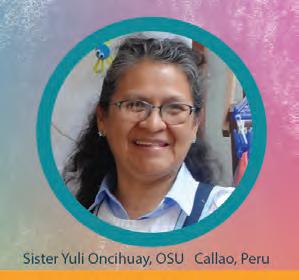
11 minute read
From the Leadership Circle
from 2022 - Spring DOME
by ursulineslou
Resilience and Perseverance
To begin talking about resilience and perseverance despite obstacles or setbacks, I need to tell you that these words express a lot of depth in what they represent in our lives. I wonder who of us has not lived each of these words in our daily lives: they are verbs, nouns, sensations and feelings that challenge us every day of our lives.
Advertisement
In my experience, resilience invites me to always stand up, despite adversities and obstacles. It’s that inner strength that tells me: “Everything will be all right, everything will be all right.” And we find it in this Bible passage: “And he took the girl by the hand and said to her: ‘Little girl, I say to you, get up.’” Mk 4:41
In these times, resilience can be found in families, at work, in the social culture in which we live, in politics and in our relationships. The pandemic and climate change have affected every human, as we have all suffered losses, including isolation, lack of work, violence, food and housing shortages, and worst of all, loss of life. In the face of every obstacle that we have experienced or are experiencing, we demonstrate the ability to continue fighting for life, to not stop, to keep going, to encourage each other by saying: “You can! You can!” By living in solidarity with each other and raising the voice of justice, we can continue to cultivate hope in the middle of the desert.
The resilience that is being lived out in many countries and the world is inspiring when millions of people who have lost their loved ones to the coronavirus continue to say, “Here, we are!” As Saint Angela Merici advises us: “Do not be discouraged, do not lose confidence, put your hope in God.” This is a resilient message since it invites us to face all obstacles and setbacks just as Angela lived through in her own time. Resilience and fortitude have taught us to be more in solidarity with each other and to enlarge our hearts with God’s favored ones—those on the margins: immigrants, those who have suffered through racism, environmental catastrophes, and the LGBT community. When made aware of this suffering, people of faith gather together to reconcile with their brothers and sisters who are the face of the living God.
An example of resilience is what the people of Honduras suffered when a group of environmental activists who were defending their river, Rio Guapinol, against mining were arrested as criminals. They had organized to defend their rights peacefully and seek justice for their Honduran brothers and sisters. Numerous charges were brought against them, including charges of violence. All charges have since been dismissed. The defense of water began in the ’90s with the death of the activist Berta Cáceres, and until now they continued to fight in defense of our common home, which is our land, “la Pachamama.” I can say, then, that resilience and perseverance can be cultivated; they can be found and brought together to face adverse conditions.
In conclusion, I share this message from the Bible: “I will be with you until the end of time.” Mt 28:20 It expresses and reminds us that God will always be with us in the difficult moments of our lives.
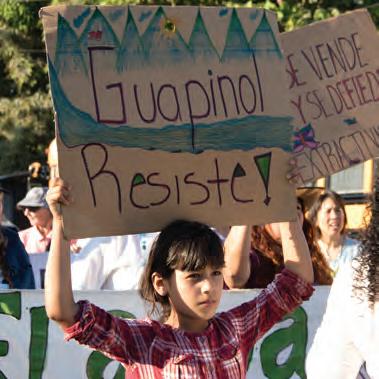
We row, knowing what the price is Remamos, sabiendo cuál es el precio
with clenched fists Con los puños apretados Without thinking of stopping Sin pensar en detenernos We row, with our faces against the wind Remamos, con la cara contra el viento
with courage ahead Con la valentía delante
With a town between the fingers Con un pueblo entre los dedos We row, with a knot, here, in the chest Remamos, con un nudo, aquí, en el pecho Dreaming that on the other side Soñando que al otro lado Another start is coming Se avecina otro comienzo
—From Remamos, a song by
Kany García and Natalia Lafourcade
Sister Yuli Oncihuay, OSU Councilor, Ursuline Sisters of Louisville

The Story of the Ursuline Chapel
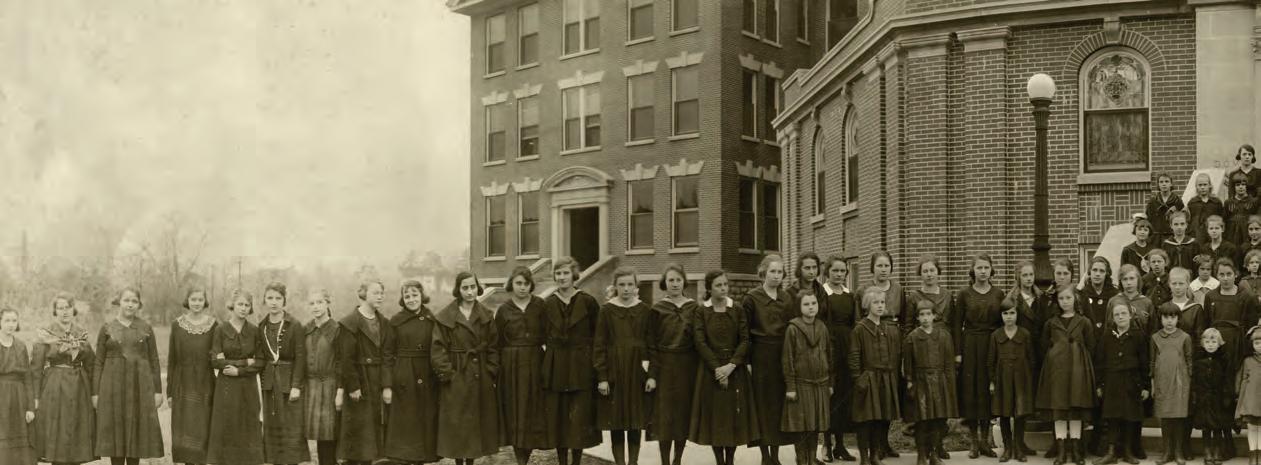
The story of our Motherhouse chapel, the Ursuline Chapel of the Immaculate Conception, is one of resilience and perseverance over the past 100+ years.
One must begin with the harrowing journey that the three Ursuline Sisters from Straubing, Bavaria, took to arrive in Louisville in 1858. The first ship they were to take, the Austria, caught fire before reaching their port. The ship they ultimately took, the Ariel, was rammed by a Turkish man-o-war as they landed in New York Harbor on October 21, 1858.1 Sister Salesia Reitmeier, their young leader, had been given the equivalent of $22.50 for traveling expenses—small change even then. Resilience.
Arriving by steamboat in Louisville on October 31, 1858, the Sisters then set about their task of teaching the children of German American immigrants at Saint Martin school at Shelby and Gray streets. They soon opened a grade school for girls, a high school that took boarders, a training school for teachers and a novitiate. Mother Salesia dedicated herself to the construction of a chapel at Shelby and Chestnut streets. She told the Sisters, “A convent without a church is only halfwork.”2 A wall collapsed during construction, delaying the project, and Mother Salesia took
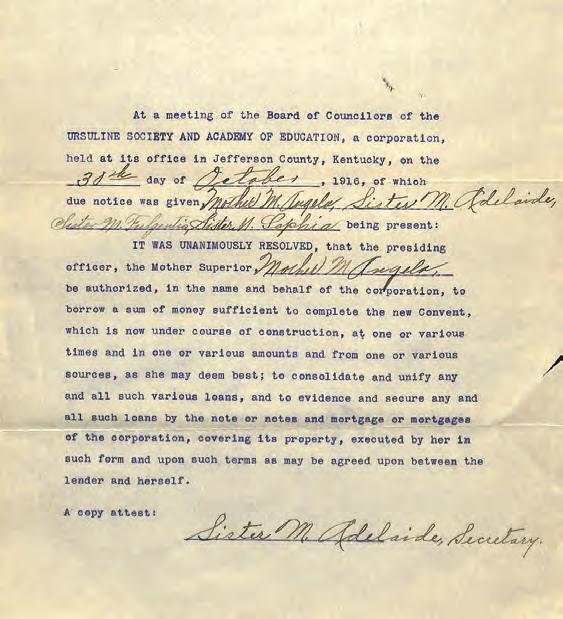
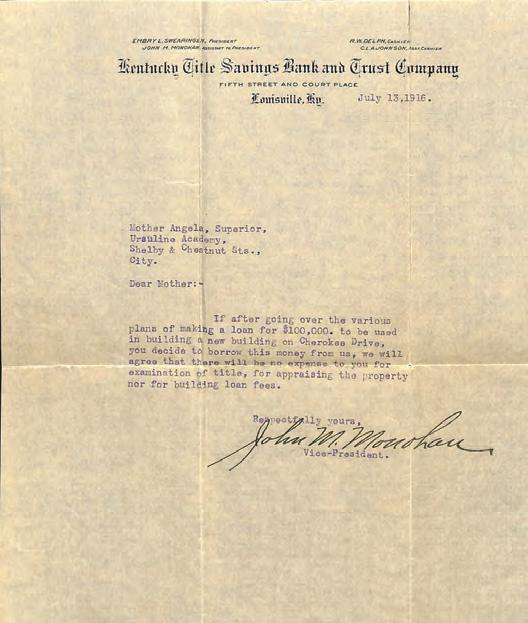
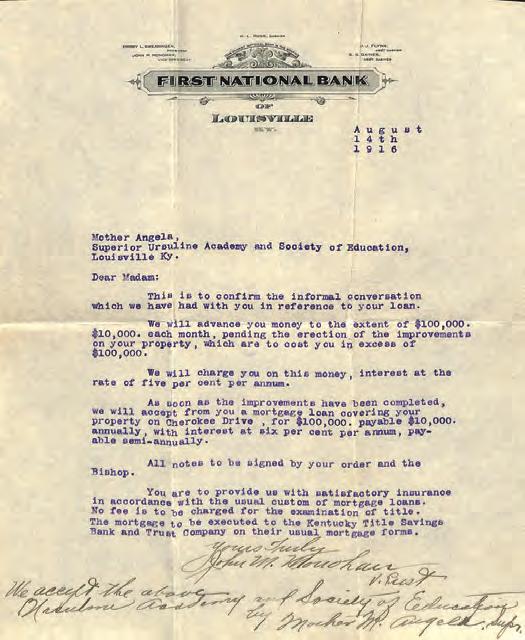
of the Immaculate Conception
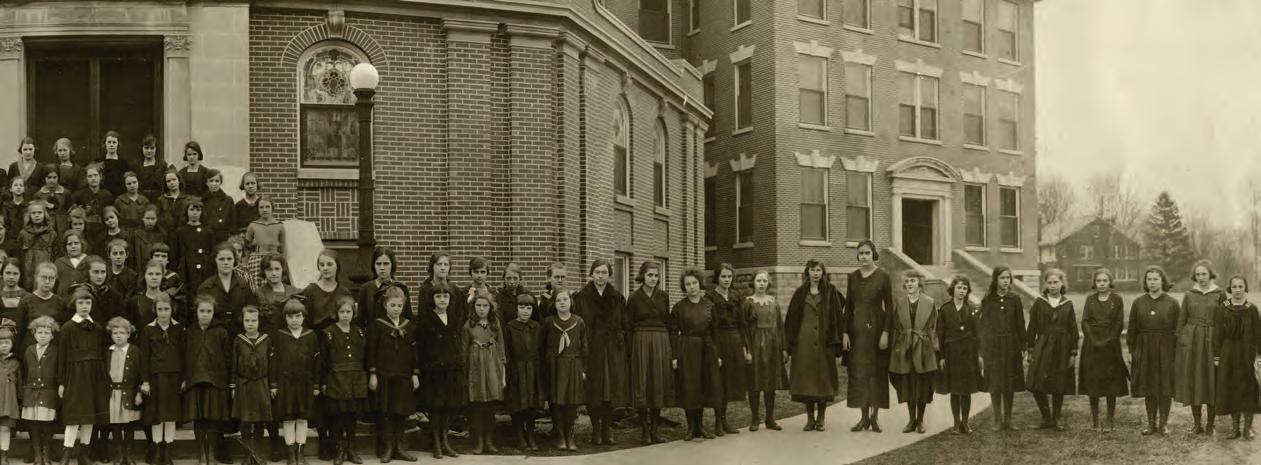
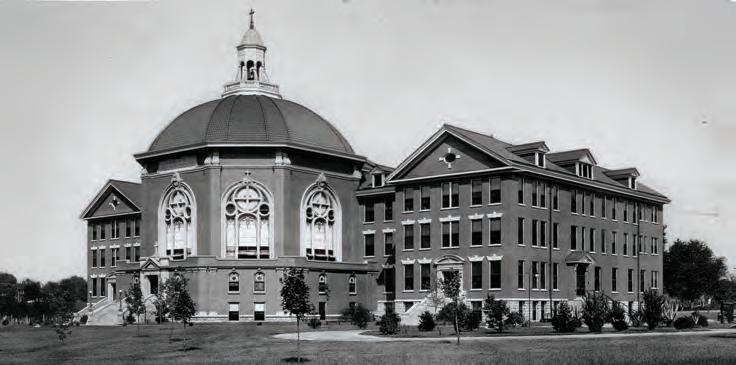
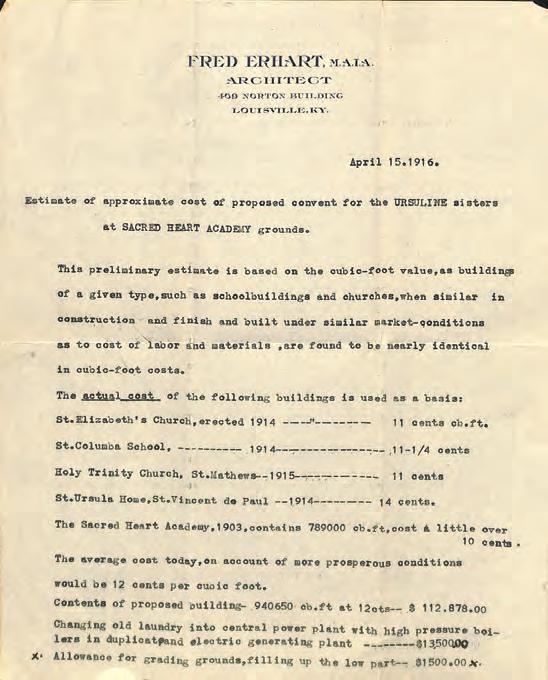
ill and died on June 25, 1868, six months before the chapel was dedicated. And yet, the community of Ursulines had grown in number to over 40 members and the chapel was completed. Perseverance.
Mother Martina Nicklas, the second Mother Superior, purchased land “in the country” in 1877 on Workhouse Road, now Lexington Road. In a three-story mansion on the estate, the Ursuline Sisters opened the Academy of the Sacred Heart, which was a coed school for grades one through twelve. In 1916, Mother Angela
Leininger directed the construction of a new convent and chapel on the property, to replace the Motherhouse on East Chestnut Street near Shelby Street, part of which had been built in the 1860s. In order to fund the building of the new Motherhouse and chapel, the Ursuline Board of Councilors authorized Mother Angela “to borrow a sum of money sufficient to complete the new convent.”
At the same time, Ursuline Sisters of Louisville were spreading out across the country to staff schools in Maryland, Pennsylvania,

1. Approval letter from the Board of
Councilors 2. Loan letter from Kentucky Title
Savings Bank and Trust Company 3. Signed loan agreement from First
National Bank 4. Estimate of cost per cubic foot, 12 cents 5. Architect’s fees
Indiana, Ohio, West Virginia and Nebraska. The Sisters often faced hardships in the remote areas in which they were sent, but they carried out their duties faithfully. Resilience.
The chapel, with its domed ceiling, was to be the centerpiece of the Motherhouse building. The architect was Fred Erhart. Ground was broken on August 1, 1916, and the cornerstone laid on December 8, 1916, the feast of the Immaculate Conception. “Sisters and pupils of Sacred Heart Academy formed the procession which left the Academy building at 2:30 p.m. Rev. Geo W. Shumann, D.D., ecclesiastical superior of the community performed the ceremony, and he was assisted by Rev. Paul J. Volk, chaplain of the Academy.” 3
One year later, on December 8, 1917, the dedication of the new Motherhouse and chapel took place. “The temperature that day was the coldest and the snow the deepest in Kentucky’s history.” 4 Bishop Denis O’Donaghue’s car got stuck in a snowdrift, but that did not stop the ceremony—or the bishop apparently, as he arrived in time to celebrate Mass. Perseverance.
Throughout the years, the Ursuline Sisters have gathered strength from their prayer and worship together in their beautiful chapel to go out into the mission field to serve others. Although the Sisters’ work was primarily in education, in October 1918, fifteen Ursulines of Louisville went to nearby Camp Zachary Taylor to serve as nurses during the influenza epidemic. Surely when they returned to the Motherhouse after such an arduous task and attended Mass in the Motherhouse chapel, it was of great comfort to them.
During the Great Flood of the Ohio River in January 1937, about 230,000 of Louisville’s 350,000 inhabitants were forced to leave their homes and find safety on higher ground. The Ursulines took refugees in and housed them on campus. And the Ursulines themselves “kept as warm as we could during the day huddled in one large room with two coal stoves and we ate our supper, said our morning and night prayers and retired by the light of candles. We had running water for only two hours each day.”5 Resilience.
Over the decades, various improvements and changes were made to the chapel. In 1944 the chapel was frescoed by Mr. Ed Partusch.6 In 1957 the chapel was painted and pews revarnished. In 1980 it was rewired and the dome ceiling repainted.
In 1991, in preparation for the celebration of the 75th anniversary of the chapel, major renovations were made to follow the basic principles for liturgical space. The arrangement of pews was altered so that the altar and ambo were visible from any seat, the two side altars were removed and smaller Stations of the Cross and the crucifix were placed in the rear of the chapel. The main altar was now free-standing, although the original baroque altar was left in place.
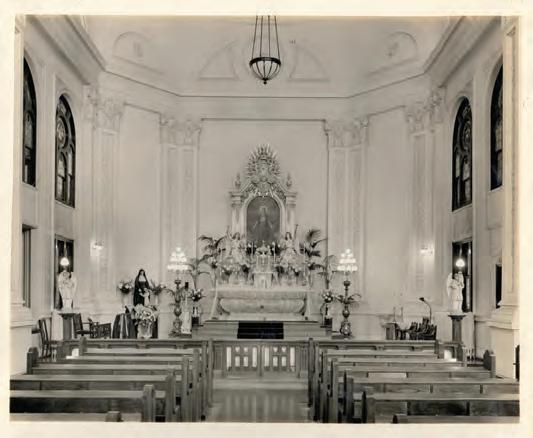
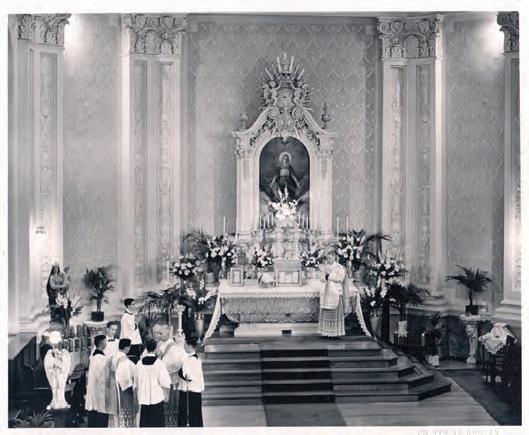
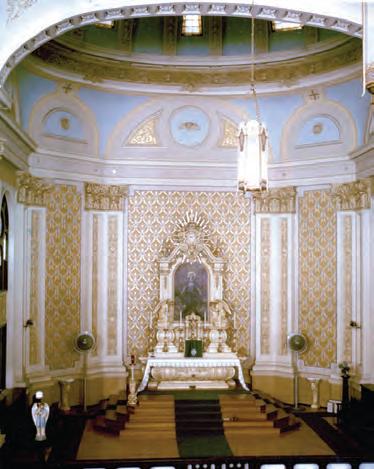
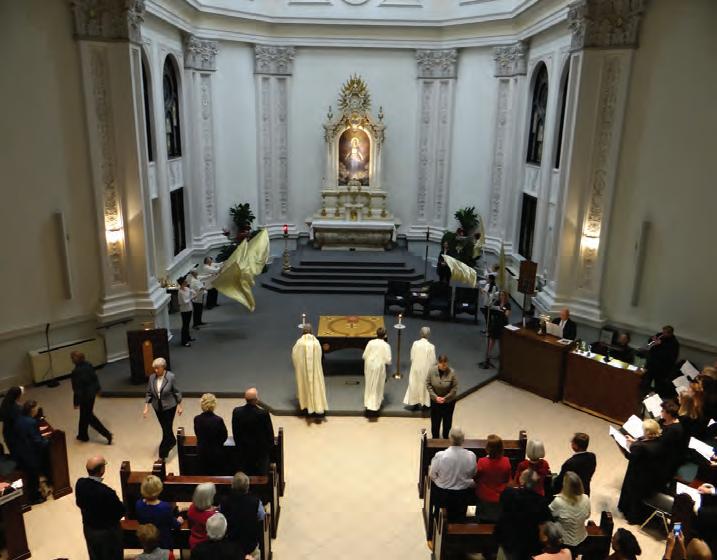
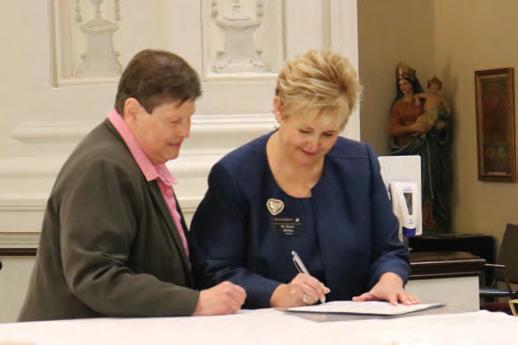
—Sister Jean Anne Zappa
A $3.5 million preservation campaign was started in 2017 by the Ursulines to celebrate the centennial of the chapel. In addition to continuing to be a sacred space for the Ursuline Sisters and Sacred Heart Schools, since 1997 the chapel has served the homebound by providing the location where Mass of the Air is videotaped by the archdiocese.
Following a Mass to celebrate St. Angela Merici’s feast day on January 27, 2022, the Ursuline Sisters officially transferred the Chapel Preservation Fund to Sacred Heart Schools, which are sponsored by the Ursuline Sisters. Giving thanks to the donors who made the fund possible, Ursuline President Sister Jean Anne Zappa presented Dr. Karen McNay, president of Sacred Heart Schools, the donor restricted funds.
This gift builds on the one that the Ursulines gave to Sacred Heart Schools in June 2019: the lease transfer of all buildings and land on the 48-acre Ursuline campus. In their wisdom, the Ursuline Sisters discerned that by giving this gift, it would allow them to continue other ministries and focuses as they become fewer in number. Perseverance.
Other recent repairs and upgrades made to the chapel include new carpet, plaster repairs and painting of the chapel court, and protective windows installed over the stained-glass windows. The transfer of the fund will allow Sacred Heart Schools to preserve the Motherhouse chapel on the Ursuline campus into perpetuity for future generations.
Ursuline President Sister Jean Anne Zappa reflected, “Saint Angela called us to ‘build community wherever you go.’ We see this gift to Sacred Heart Schools as not just preserving a beautiful and sacred space, but living out Angela’s words and charism. Our hearts are nourished as we celebrate and give glory to God together in this chapel, and it leads us to build community with others when we go out to serve in the world.”
Resilience. Perseverance. And faith.
Above: Sister Jean Anne Zappa and Dr. Karen McNay sign the Chapel Fund transfer.
Left: The chapel through the years, 1933 through today.
1, 2 Sacred Heart Academy: 125 Years of Excellence in Education Rooted In Ursuline Tradition, copyright 2002, published by Ursuline Campus
Schools, foreword by Dianne Aprile 3, 4 Excerpts from “Annals of the Ursuline Convent of the Immaculate Conception: 1914-1932” 5 Excerpts from “Annals of the Ursuline Convent of the Immaculate Conception: 1932–1942” 6 Excerpts from “Annals of the Ursuline Convent of the Immaculate Conception: 1944–1948”










